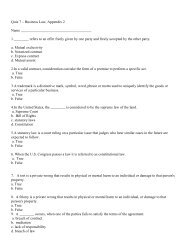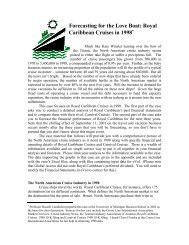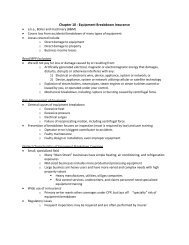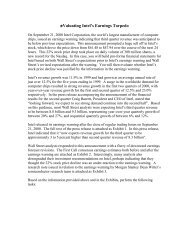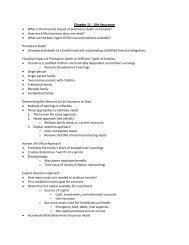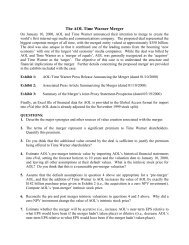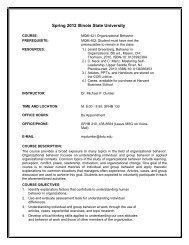The Tale of Two Movie Theaters
The Tale of Two Movie Theaters
The Tale of Two Movie Theaters
- No tags were found...
Create successful ePaper yourself
Turn your PDF publications into a flip-book with our unique Google optimized e-Paper software.
A <strong>Tale</strong> <strong>of</strong> <strong>Two</strong> <strong>Movie</strong> <strong>The</strong>aters ∗This case compares the financial statistics <strong>of</strong> two movie theater companies; onethat defaulted on its debt and filed for bankruptcy in 2000 and the one that did not. Yourtask is to predict which company will ultimately be the one who declares bankruptcy.Until the solution <strong>of</strong> the case is presented, we will refer to the two companies as CountryCinema and City Screens.<strong>The</strong> <strong>Movie</strong> <strong>The</strong>ater IndustryAttending a theatrical movie remains a thriving entertainment activity in NorthAmerica, with ticket sales topping $7.6 billion in 2000. While the number <strong>of</strong> movieattendees has declined slightly in recent years, the decline has been more than <strong>of</strong>fset byincreases in ticket prices, resulting in healthy year-to-year ticket revenue growth (seefigure 1). But despite the overall increase in sales, the movie theater industry hasstruggled in recent years. <strong>The</strong> number <strong>of</strong> screens has increased 34% since 1995,somewhat less than the total box <strong>of</strong>fice sales growth, but the cost <strong>of</strong> operating so manynew screens has outstripped the increase in revenue. Multiplexes, theaters with eight ormore screens, have become the industry standard, and megaplexes, theaters with at leastten screens and stadium-style seating, have grown rapidly in popularity. While the multiscreentheater format <strong>of</strong>fers many advantageous operating features – the ability tooptimally match the theater size with the audience and a more evenly-spaced demand forconcession services – it has also requires significant capital expenditures on stadiumseating and state-<strong>of</strong>-the-art sound and projection equipment. <strong>The</strong> popularity <strong>of</strong> the newtheater options has caused many older theaters to suffer, necessitating asset write-downs.Finally, the increased competition between screens has caused marketing costs to rise54% since 1995 and shorter runs have raised the rental fees to distributors (which averageabout 50% <strong>of</strong> the total box <strong>of</strong>fice). 1Figure 1: North American <strong>Movie</strong> <strong>The</strong>ater Statisticsbox <strong>of</strong>ficegross salesaverageticket price attendance# <strong>of</strong>screens# <strong>of</strong>theatersaveragescreens/theater1995 $5494 M $4.35 1263 M 27805 7744 3.61996 $5912 M $4.42 1339 M 29690 7798 3.81997 $6366 M $4.59 1388 M 31640 7480 4.21998 $6949 M $4.69 1481 M 34186 7418 4.61999 $7448 M $5.08 1465 M 37185 7551 4.92000 $7661 M $5.39 1421 M 37396 7421 5.0source: Motion Picture Association <strong>of</strong> America∗ Pr<strong>of</strong>essor Lundholm prepared this case as the basis <strong>of</strong> class discussion.1 First-run motion picture rental fees are generally the greater <strong>of</strong> (i) 70% <strong>of</strong> box <strong>of</strong>fice admissions, graduallydeclining to as low as 30% over a period <strong>of</strong> four to seven weeks, and (ii) a specified percentage (i.e., 90%)<strong>of</strong> the excess <strong>of</strong> box <strong>of</strong>fice receipts over a negotiated allowance for theatre expenses (commonly known asa " 90/10" clause). Second-run motion picture rental fees typically begin at 35% <strong>of</strong> box <strong>of</strong>fice admissionsand <strong>of</strong>ten decline to 30% after the first week (source – 10K <strong>of</strong> City Screens).
<strong>Two</strong> <strong>Movie</strong> <strong>The</strong>ater Companies<strong>The</strong> two companies in this case are approximately the same size, each withapproximately 2800 screens as <strong>of</strong> fiscal 2000. For each company, ticket sales constituteapproximately 65% <strong>of</strong> revenues, followed by concessions which make up roughly 30% <strong>of</strong>revenues, with the remainder coming from video games and on-screen advertising. <strong>The</strong>two companies differ significantly in the size <strong>of</strong> town they operate in. Country Cinema,as we will call it, targets small to mid-sized communities. As <strong>of</strong> 2000 the management <strong>of</strong>Country Cinema believes it was the sole exhibitor in approximately 65% <strong>of</strong> is areas. Incontrast, City Screens operates 69% <strong>of</strong> its domestic screens in the 20 largest “designatedmarket areas” (as defined by Nielsen Media), as well as operating in certain largeinternational cities.Who will default -- Country Cinema or City Screens?From 1995 to 2000 both companies were expanding rapidly and changing over tomultiplex and megaplex theater formats. And both were borrowing heavily to fund theirgrowth and remodeling costs. But one company stumbles in the summer <strong>of</strong> 2000 anddefaults on its loans. <strong>The</strong> summer season is traditionally the highest volume period formovie theater attendance, but the summer <strong>of</strong> 2000 failed to deliver any blockbustermovies and attendance suffered. Consequently, one <strong>of</strong> the companies did not generatesufficient cash flow to stay within its loan covenants.<strong>The</strong> detailed requirements <strong>of</strong> each company’s loan covenants fill hundreds <strong>of</strong>pages but the basic idea behind them is very simple. <strong>The</strong> covenants place limits onadditional borrowing and on payments to equityholders. <strong>The</strong>y also describe a number <strong>of</strong>financial health measures so that, if the company starts to get too sick, the bank candeclare the loan in technical default. This makes the loan immediately due and payablein full, allowing the bank the opportunity to claim assets before they are all gone.<strong>Two</strong> measures <strong>of</strong> financial health for Country Cinema and City Screens are theTotal Leverage Ratio, roughly defined as Total Debt/EBITDA before non-recurringitems; and the Fixed Charges Coverage Ratio, roughly defined as EBITDA plus rent/interest plus rent, where rent is the rent expense on operating leases and Debt includescapital leases. At the time <strong>of</strong> the case both companies were required to maintain theTotal Leverage Ratio below 6 and the Fixed Charges Coverage Ratio above 1.25.However, the precise definition <strong>of</strong> EBITDA differed between the two companies. <strong>The</strong>definition <strong>of</strong> EBITDA in the Country Cinema covenants was basically the traditionalearnings before interest, taxes, depreciation and amortization, and before any nonrecurringitems such as gains/losses on asset sales or restructuring charges. For CityScreens the definition was more forward-looking, excluding the performance <strong>of</strong> theatersscheduled to close and extrapolating the performance <strong>of</strong> theaters that were recentlyopened into the near future.RequirementsYour task is simply to forecast which company you believe will default in thesummer <strong>of</strong> 2000, and justify your prediction. <strong>The</strong>re is much data available to you. <strong>The</strong>case materials are as follows:2
1) A spreadsheet with Global-Access formatted financial statements and, at the bottom,many financial ratios from fiscal 1995 through 1998, including the financial ratios andthe default probability predictions for the Moody’s RiskCalc model. This model and itspredictions are discussed in the eVal textbook. <strong>The</strong> spreadsheet is formatted for importinto eVal. <strong>The</strong> ratios are reproduced below; the entire spreadsheet is availableelectronically.2) <strong>The</strong> fiscal 1998 financial statements and excerpts from the MD&A for bothcompanies. Note that the 1998 fiscal year end for City Screens is actually April 1, 1999.Please note: the exact definitions <strong>of</strong> the financial health measures given in the loancovenants for each company are extremely detailed, and you do not have sufficientinformation to reconstruct them. <strong>The</strong> details about the covenants given above and ageneral investigation into the financial health and risk exposure <strong>of</strong> each company will besufficient to guide your analysis.3
Country Cinema Financial RatiosMoody's Ratios (see the handout "Predicting Debt Defaults" for further explanation)FISCAL YEAR ENDING 12/31/98 12/31/97 12/31/96 12/31/95Net Income/Assets -0.044 0.033 -0.015 0.027change in Net Income/Assets -0.076 0.047 -0.042 -0.018Liabilities/Assets 0.676 0.673 0.636 0.613EBIT/Interest -0.793 2.407 0.421 2.355Assets/CPI (millions) 428 386 312 314Quick Ratio 0.295 0.443 0.437 0.653Cash/Assets 0.025 0.027 0.011 0.024Inventory/COGS 0.019 0.016 0.015 0.019Sales Growth 0.050 0.075 0.170 0.113Implied Default Probability 12/31/98 12/31/97 12/31/96 12/31/95Net Income/Assets 0.055 0.030 0.055 0.030change in Net Income/Assets 0.055 0.035 0.050 0.040Liabilities/Assets 0.055 0.055 0.055 0.045EBIT/Interest 0.085 0.030 0.070 0.030Assets/CPI (millions) 0.035 0.045 0.045 0.045Quick Ratio 0.090 0.065 0.065 0.050Cash/Assets 0.059 0.059 0.055 0.059Inventory/COGS 0.045 0.045 0.045 0.045Sales Growth 0.030 0.030 0.032 0.030RiskCalc default probability 0.048 0.039 0.046 0.036Other Ratios 12/31/98 12/31/97 12/31/96 12/31/95rent expense (from footnotes) 66,800 57,600 54,800 45600Fixed Charge Coverage 1.66 1.82 1.83 1.79Total Debt/EBITDA (b/f nonrecurringcharges) 3.96 4.05 3.21 3.504
City Screens Financial RatiosMoody's Ratios (see the handout "Predicting Debt Defaults" for further explanation)FISCAL YEAR ENDING 4/1/99 4/2/98 4/3/97 3/28/96Net Income/Assets -0.016 -0.031 0.026 0.057change in Net Income/Assets 0.014 -0.057 -0.030 -0.008Liabilities/Assets 0.882 0.825 0.764 0.671EBIT/Interest 0.314 -0.152 2.448 2.619Assets/CPI (millions) 599 496 458 317Quick Ratio 0.543 0.616 0.626 0.440Cash/Assets 0.014 0.012 0.034 0.022Inventory/COGS 0.000 0.000 0.000 0.000Sales Growth 0.204 0.133 0.144 0.165implied default probabilities 4/1/99 4/2/98 4/3/97 3/28/96Net Income/Assets 0.055 0.055 0.030 0.020change in Net Income/Assets 0.030 0.050 0.040 0.030Liabilities/Assets 0.090 0.090 0.070 0.055EBIT/Interest 0.070 0.070 0.030 0.030Assets/CPI (millions) 0.035 0.035 0.035 0.045Quick Ratio 0.050 0.050 0.050 0.065Cash/Assets 0.059 0.055 0.059 0.059Inventory/COGS 0.030 0.030 0.030 0.030Sales Growth 0.032 0.030 0.030 0.032Riskcalc 0.053 0.054 0.044 0.042Other Ratios 4/1/99 4/2/98 4/3/97 3/28/96rent expense (from footnotes) 165,370 106,383 80,061 64813Fixed Charge Coverage 1.31 1.50 1.89 1.89Total Debt/EBITDA (b/f non-recurringcharges) 5.95 3.78 3.31 1.675
Country Cinema fiscal 1998 MD&A and Financial StatementsMANAGEMENT'S DISCUSSION AND ANALYSISASSET IMPAIRMENTS AND RESTRUCTURING CHARGE<strong>The</strong> opening <strong>of</strong> large multiplexes and theatres with stadium seating by Country Cinema andcertain <strong>of</strong> its competitors has tended to, and is expected to continue to, draw audiences away from certainolder theatres, including theatres operated by Country Cinema. In addition, demographic changes andcompetitive pressures can lead to the impairment <strong>of</strong> a theatre. Country Cinema reviews for impairment <strong>of</strong>long-lived assets and goodwill related to those assets to be held and used in the business whenever eventsor changes in circumstances indicate that the carrying amount <strong>of</strong> an asset or a group <strong>of</strong> assets may not berecoverable. In the fourth quarter <strong>of</strong> 1998, Country Cinema identified impairments <strong>of</strong> asset values for 145theatres with 610 screens. <strong>The</strong> 145 theatres included a further impairment for 46 theatres that were part <strong>of</strong>the 1996 impairment charge (see discussion below). <strong>The</strong>re can be no assurance that Country Cinema willnot take additional charges in the future related to the impairment <strong>of</strong> assets.<strong>The</strong> 1998 impairment charge <strong>of</strong> approximately $38.3 million (approximately $24.1 million after incometaxes or $2.12 per diluted share) is a non-cash charge which reduced the carrying value <strong>of</strong> property andequipment by $29.4 million (costs <strong>of</strong> $49.0 million less accumulated depreciation and amortization <strong>of</strong>$19.6 million) and the excess <strong>of</strong> purchase price over net assets <strong>of</strong> businesses acquired by $8.9 million.<strong>The</strong> 1998 impairment was primarily caused by reductions in estimated theatre cash flows due to (i) theimpact <strong>of</strong> new or increased competition on certain <strong>of</strong> Country Cinema's older, auditorium-style theatres,(ii) Country Cinema's negative evaluation <strong>of</strong> the operating results produced from theatres previouslyconverted to discount houses or (iii) Country Cinema's inability to improve a marginal theatre's operatingresults.As a result <strong>of</strong> the reduced carrying amount <strong>of</strong> the impaired assets due to the 1996 impairment charge,depreciation and amortization expense for 1998, 1997 and 1996 was reduced by approximately $3.5million, $3.8 million and $4.2 million, respectively (1998 -- $2.2 million after income taxes or $.19 perdiluted share; 1997 -- $2.4 million after income taxes or $.21 per diluted share; 1996 -- $2.6 million afterincome taxes or $.23 per diluted share). Depreciation and amortization for 1999 will be reduced byapproximately $6.7 million as a result <strong>of</strong> the 1998 and 1996 impairment charges.<strong>The</strong> 1998 and 1996 impairment charges are reflected as operating expenses in Country Cinema'sConsolidated Financial Statements.Restructuring ChargeIn December 1998, Country Cinema's Board <strong>of</strong> Directors approved a restructuring plan involving theclosure or disposition <strong>of</strong> 28 theatres (116 screens) in certain markets that did not fit Country Cinema'soperating and growth strategies (the "Restructuring Plan"). In accordance with the Restructuring Plan, thetheatres are scheduled to be closed during 1999. Country Cinema has recognized a charge <strong>of</strong>approximately $34.7 million (approximately $21.5 million after income taxes or $1.89 per diluted share)to establish reserves for the future cash expenditures related to these theatres. <strong>The</strong> established reserves areprimarily for future lease payments payable in accordance with the terms <strong>of</strong> the lease agreements and forcertain lease related costs. <strong>The</strong>re are no material employee termination costs as a result <strong>of</strong> the closure <strong>of</strong>these theatres. Disbursements <strong>of</strong> the restructuring reserves for 1999 are estimated to total approximately$4.6 million.Revenues during the years ended December 31, 1998, 1997 and 1996 for the theatres identified forclosure under the Restructuring Plan were approximately $8.7 million, $14.6 million and $17.3 million,
espectively. Operating income (losses) during the years ended December 31, 1998, 1997 and 1996 forthe theatres included in the Restructuring Plan were approximately $(3.6) million, $(.5) million and $1.1million, respectively.Year Ended December 31, 1998 Compared to Year Ended December 31, 1997Total revenues for the year ended December 31, 1998 increased 5.0% to $481.6 million from $458.6million. This increase consists <strong>of</strong> an $11.3 million increase in admissions and an $11.7 million increase inconcessions and other. <strong>The</strong>se increases are due primarily to the additional revenues generated by theincrease in the average number <strong>of</strong> screens in operation and an increase in the average concessions sale perpatron, partially <strong>of</strong>fset by the loss in revenues at theatres closed during the period for renovation.Attendance per average screen was 28,453 for 1998 compared to 28,493 for 1997. Revenue per averagescreen was $176,205 for 1998 compared to $173,449 for 1997. Average admission prices were relativelyunchanged at $4.25 for 1998 compared to $4.24 the previous year with the average concessions sale perpatron increasing 6.5% to $1.79 for 1998 from $1.68 for 1997.Cost <strong>of</strong> theatre operations (film exhibition costs, concession costs and other theatre operating costs)increased 6.2% to $385.6 million from $363.1 million due to films that did not play for an extendedperiod <strong>of</strong> time, which provides greater percentage payments to the distributors, more screens in operationand higher attendance numbers. As a percentage <strong>of</strong> revenue, cost <strong>of</strong> operations increased from 79.2% <strong>of</strong>total revenues in 1997 to 80.1% <strong>of</strong> total revenues in 1998.General and administrative costs increased 10.9% to $7.1 million from $6.4 million reflecting additionalgeneral and administrative costs incurred in connection with the additional screens added in 1997 and1998. As a percentage <strong>of</strong> total revenues, general and administrative costs increased only slightly to 1.47%from 1.40% in 1997.Depreciation and amortization increased 12.3% to $37.5 million from $33.4 million as a result <strong>of</strong> theincreased screens in operation from the Company's acquisitions and expansions in 1997 and 1998. <strong>The</strong>seamounts have also been reduced due to the 1996 impairment charge from the Company's adoptingStatement No. 121 (see Note B <strong>of</strong> Notes to Consolidated Financial Statements).Other Operating DataAS OF DECEMBER 31,---------------------------------------------------------------------------1994 1995 1996 1997 1998---------------------------------------------------------------------------OPERATING DATA:<strong>The</strong>atre locations (5) ... 445 519 519 520 468Screens (5) .............. 1,942 2,383 2,518 2,720 2,658Average screens per location ...... 4.4 4.6 4.9 5.2 5.7Total attendance (in thousands) . 59,660 64,496 74,213 75,336 77,763Total average screens in operation 1,852 2,151 2,476 2,644 2,733Average ticket price ...........$ 3.89 $ 3.93 $ 4.00 $ 4.24 $ 4.25Average concession per patron . $ 1.46 $ 1.59 $ 1.62 $ 1.68 $ 1.79(5) Excludes 28 theatres with 116 screens at December 31, 1998, which will be closed byCountry Cinema in accordance with its restructuring plan.2
LIQUIDITY AND CAPITAL RESOURCESCountry Cinema entered into a revolving credit facility on October 17, 1997, and amended and restated this facility onJanuary 29, 1999. <strong>The</strong> Revolving Credit Facility matures November 10, 2002 and bears interest at LIBOR plus 2.25%.Country Cinema is obligated to pay a commitment fee <strong>of</strong> .5% on the unused portion <strong>of</strong> the facility. In addition, onFebruary 25, 1999 Country Cinema entered into a $75.0 million Term Loan B, the proceeds <strong>of</strong> which were applied torepay revolving credit borrowings. <strong>The</strong> Term Loan B matures March 30, 2005 and bears interest at LIBOR plus 2.75%.Following application <strong>of</strong> the proceeds <strong>of</strong> the Term Loan B, the maximum available borrowings under the RevolvingCredit Facility was reduced from $275.0 million to $200.0 million. At March 15, 1999, Country Cinema had $108.9million available for borrowings under the Revolving Credit Facility.Country Cinema also obtains liquidity through its theatre leasing arrangements. <strong>The</strong> cost <strong>of</strong> constructing a new theatreis reduced substantially if Country Cinema leases the real estate and improvements rather than purchasing them. As <strong>of</strong>December 31, 1998, Country Cinema had 49 ground leases and 322 ground and improvement leases, excluding theatresscheduled to be closed in 1999. Minimum annual rent payments on these theatres totaled $53.1 million in 1998 and areexpected to increase in 1999. Country Cinema is a party to a master lease facility (the "Master Lease") with <strong>Movie</strong>plexRealty Leasing, L.L.C., which provides up to $75.0 million for financing the development <strong>of</strong> multiplex theatres, <strong>of</strong>which approximately $52.8 million was available as <strong>of</strong> December 31, 1998. <strong>The</strong>atres leased pursuant to the MasterLease have lease terms <strong>of</strong> 16 years. In connection with the amendment and restatement <strong>of</strong> the Revolving Credit Facilityon January 29, 1999, Country Cinema also amended and restated its Master Lease to provide for security interests andguarantees and to amend certain covenants contained therein.Country Cinema's capital expenditures arise principally in connection with the development <strong>of</strong> new theatres, renovationand expansion <strong>of</strong> existing theatres and theatre acquisitions. During 1998, such capital expenditures totaled $146.7million, net <strong>of</strong> lease financings. Country Cinema estimates that capital expenditures for 1999 will be approximately$129.0 million, net <strong>of</strong> any lease financings. Country Cinema expects to build 22 new theatres having an aggregate <strong>of</strong>334 screens, add 48 stadium seating auditoriums to existing theatres, and retr<strong>of</strong>it approximately 83 existing auditoriumsin 1999. Country Cinema estimates that the average cost <strong>of</strong> a new 16-screen multiplex willbe approximately $9.0 million ($4.0 million if the land and improvements are leased rather than owned). CountryCinema intends to enter into leasing arrangements whenever possible in order to minimize capital requirements.Country Cinema expects that capital expenditures for theatre construction, expansion and renovation will beapproximately $75.0 million, net <strong>of</strong> lease financings for 2000. Country Cinema believes that its currently anticipatedcapital needs for theatre construction, expansion and renovation and possible acquisitions for at least the next two yearswill be satisfied by the cash and cash equivalents and short-term investments on hand, borrowings under the RevolvingCredit Facility, additional sale <strong>of</strong> debt and/or equity securities, additional bank financings and other forms <strong>of</strong> long-termdebt and internally generated cash flow. Additionally, Country Cinema may supplement its current sources <strong>of</strong> capitalthrough sales and leasebacks <strong>of</strong> theatre properties where market conditions for such transactions are favorable.Our ability to make scheduled payments <strong>of</strong> principal <strong>of</strong>, or to pay the interest on, or to refinance our indebtedness, or t<strong>of</strong>und planned capital expenditures for theatre construction, expansion, renovation or acquisition will depend on ourfuture performance. Our future performance is, to a certain extent, subject to general economic, financial, competitive,legislative, regulatory and other factors that are beyond our control. Based upon our current level <strong>of</strong> operations andanticipated increases in revenues and cash flow as a result <strong>of</strong> our theatre construction, expansion and renovationprogram, and the scheduled closing <strong>of</strong> certain underperforming theatres, we believe that cash flow from operations andavailable cash, together with available borrowings under the Revolving Credit Facility, lease financing arrangementsand/or sales <strong>of</strong> additional debt or equity securities, will be adequate to meet our future liquidity needs for at least thenext two years.We cannot assure you, however, that our business will generate sufficient cash flow from operations, that currentlyanticipated revenue growth and operating improvements will be realized or that future capital will be available to usfrom the sale <strong>of</strong> debt or equity securities, additional bank financings, other long-term debt or lease financings in anamount sufficient to enable us to pay our indebtedness, or to fund our other liquidity needs. We may need to refinanceall or a portion <strong>of</strong> our indebtedness on or before maturity. We cannot assure you that we will be able to refinance any <strong>of</strong>our indebtedness or raise additional capital through other means, on commercially reasonable terms or at all.3
Country Cinema fiscal 1998 MD&A and Financial StatementsDECEMBER 311998 1997--------- ---------ASSETSCURRENT ASSETSCash and cash equivalents $ 17,771 $ 16,545Short-term investments 801 3,042Accounts and notes receivable 522 758Inventories 3,851 3,082Prepaid expenses 5,886 5,448Recoverable construction allowances under capitalleases -0- 2,100--------- ---------TOTAL CURRENT ASSETS 28,831 30,975OTHER ASSETSInvestments in and advances to partnerships 20,334 14,148Deferred income taxes-- Note I 14,059 -0-Other 3,753 9,669--------- ---------38,146 23,817PROPERTY AND EQUIPMENT -- Notes B, D, E and FLand 60,846 59,546Buildings and improvements 261,887 184,769Leasehold improvements 176,004 177,970Leasehold interests 22,221 37,921Equipment 212,976 185,955--------- --------733,934 646,161Accumulated depreciation and amortization (160,322) (149,105)--------- ---------573,612 497,056EXCESS OF PURCHASE PRICE OVER NETASSETS OF BUSINESSES ACQUIRED 56,954 68,149--------- ---------$ 697,543 $ 619,997========= =========LIABILITIES AND SHAREHOLDERS' EQUITYCURRENT LIABILITIESAccounts payable $ 45,533 $ 26,122Accrued expenses-- Notes A and C 37,842 17,833Current maturities <strong>of</strong> long-term indebtedness and capital leaseobligations 1,290 19,077-------- --------TOTAL CURRENT LIABILITIES 84,665 63,032LONG-TERM LIABILITIESLong-term debt, less current maturities-- Note E 232,013 222,242Senior Notes-- Note E 79,870 79,870Capital lease obligations,less current maturities -- Note F 38,587 39,550Restructuring reserve, less current portion -- Note C 30,099 -0-Other 6,000 -0-Deferred income taxes -- Note I -0- 12,431-------- --------386,569 354,093SHAREHOLDERS' EQUITY -- Notes D, E, G, and H5.5% Series A Senior CumulativeConvertible Exchangeable Preferred Stock 550 -0-Class A Common Stock, issued and outstanding9,942,487 and 9,918,587 shares, respectively 298 298Class B Common Stock, issued and outstanding1,420,700 shares 43 43Paid-in capital 158,543 104,677Retained earnings 66,875 97,854-------- --------226,309 202,872-------- --------697,543 619,997======== ========
Country Cinema fiscal 1998 MD&A and Financial StatementsYEARS ENDED DECEMBER 31,1998 1997 1996--------- --------- -----------Revenues:Admissions $ 330,534 $ 319,235 $ 296,629Concessions and other 151,034 139,363 130,097--------- --------- -----------481,568 458,598 426,726Costs and expenses:Film exhibition costs 177,754 169,672 156,968Concession costs 19,911 18,334 17,252Other theatre operating costs 187,870 175,103 164,149General and administrative expenses 7,115 6,352 5,959Depreciation and amortization expenses 37,502 33,443 28,408Impairments <strong>of</strong> long-lived assets-- Note B 38,300 -0- 45,447Restructuring charge-- Note C 34,699 -0- -0---------- --------- -----------503,151 402,904 418,183--------- --------- -----------OPERATING INCOME (LOSS) (21,583) 55,694 8,543Interest expense 27,230 23,142 20,289--------- --------- -----------INCOME (LOSS) BEFORE INCOME TAXES (48,813) 32,552 (11,746)Income tax expense (benefit)-- Note I (18,166) 12,366 (4,469)--------- --------- -----------NET INCOME (LOSS) (30,647) 20,186 (7,277)Preferred stock dividends (332) -0- -0---------- --------- -----------NET INCOME (LOSS) AVAILABLE FORCOMMON STOCK $ (30,979) 20,186 (7,277)========= ========= ===========
Country Cinema fiscal 1998 MD&A and Financial StatementsYEARS ENDED DECEMBER 311998 1997 1996----------- ----------- -----------OPERATING ACTIVITIESNet income (loss) $ (30,647) $ 20,186 $ (7,277)Adjustments to reconcile net income (loss) to net cashprovided by (used in) operating activities:Depreciation and amortization 37,502 33,443 28,408Impairment charges 38,300 -0- 45,447Restructuring charge 34,699 -0- -0-Deferred income taxes (26,490) 7,011 (14,811)Gain on sales <strong>of</strong> property and equipment (282) (2,202) (767)Other gains (898) -0- -0-Changes in operating assets and liabilities:Accounts and notes receivable and inventories(533) (565) 7,572Prepaid expenses (438) (85) (231)Accounts payable 19,411 4,690 (2,941)Accrued expenses and other liabilities 21,409 593 (962)----------- ----------- -----------NET CASH PROVIDED BY OPERATING ACTIVITIES 92,033 63,071 54,438INVESTING ACTIVITIESPurchases <strong>of</strong> property and equipment (146,713) (126,144) (70,926)Purchases <strong>of</strong> assets from other theatre operators -0- (11,647) (23,075)Proceeds from sales <strong>of</strong> property and equipment 6,007 8,729 1,808Decrease (increase) in:Short-term investments 2,241 4,684 (224)Other 121 (11,216) (5,781)----------- ----------- -----------NET CASH USED IN INVESTING ACTIVITIES (138,344) (135,594) (98,198)FINANCING ACTIVITIESDebt:Additional borrowings 3,215,000 2,354,594 1,205,678Repayments (3,223,979) (2,273,674) (1,167,929)Issuance <strong>of</strong> Preferred Stock, net 54,000 -0- -0-Issuance <strong>of</strong> Class A Common Stock 416 501 113Recoverable construction allowances under capitalleases 2,100 2,078 122----------- ----------- -----------NET CASH PROVIDED BY FINANCING ACTIVITIES47,537 83,499 37,984----------- ----------- -----------INCREASE (DECREASE) IN CASH AND CASH EQUIVALENTS1,226 10,976 (5,776)Cash and cash equivalents at beginning <strong>of</strong> year 16,545 5,569 11,345----------- ----------- -----------CASH AND CASH EQUIVALENTS AT END OF YEAR $ 17,771 $ 16,545 $ 5,5696
Country Cinema fiscal 1998 MD&A and Financial StatementsNOTE F -- LEASESCertain <strong>of</strong> the Company's theatres and equipment are leased under non-cancelable leases expiring invarious years through 2023. <strong>The</strong> theatre leases generally provide, among other things, for the payment <strong>of</strong>fixed monthly rentals, contingent rentals based on a percentage <strong>of</strong> revenue over a specified amount, and thepayment <strong>of</strong> property taxes, common area maintenance, insurance and repairs. <strong>The</strong> Company, at its option,can renew a substantial portion <strong>of</strong> its theatre leases, at the then fair rental rate, for various periods with themaximum renewal period totaling 40 years.Future minimum payments, by year and in the aggregate, under capital leases and non-cancelable operatingleases with terms over one year as <strong>of</strong> December 31, 1998 are as follows (in thousands):OPERATINGCAPITALLEASESLEASES---------- -----------1999 $ 48,178 $ 5,8172000 45,917 5,6682001 43,037 5,6282002 40,271 5,6892003 38,019 5,615<strong>The</strong>reafter 267,117 75,572---------- -----------Total minimum lease payments $ 482,539 103,989==========Less amounts representing interest (64,384)-----------Present value <strong>of</strong> future minimum leasepayments 39,605Less current maturities (1,018)-----------$ 38,587===========Rent expense was approximately $66.8 million, $57.6 million and $54.8 million for 1998, 1997 and 1996,respectively.
City Screens fiscal 1998 MD&A and Financial StatementsManagement's Discussion and Analysis(Note: Fiscal 1998 is for the year ending April 1, 1999)OPERATING RESULTSRevenues. Total revenues increased 20.4%, or $173,966,000, during the year(52 weeks) ended April 1, 1999 compared to the year (52 weeks) ended April 2,1998.Total domestic revenues increased 18.9%, or $150,999,000, from the prior year.Admissions revenues increased 18.4%, or $97,720,000, due to a 14.5% increase inattendance, which contributed $77,182,000 <strong>of</strong> the increase, and a 3.4% increase inaverage ticket prices, which contributed $20,538,000 <strong>of</strong> the increase. Attendance atmegaplexes (theatres with predominantly stadium-style seating) increased as a result <strong>of</strong>the addition <strong>of</strong> 11 new megaplexes with 256 screens since April 2, 1998, <strong>of</strong>fset by a3.5% decrease in attendance at comparable megaplexes (theatres opened beforefiscal 1997). Attendance at multiplexes (theatres generally without stadium-styleseating) decreased due to a 11.7% decrease in attendance at comparable multiplexes andthe closure or sale <strong>of</strong> 15 multiplexes with 83 screens since April 2, 1998. <strong>The</strong> declinein attendance at comparable multiplexes was related primarily to certain multiplexesexperiencing competition from new megaplexes operated by the Company and othercompeting theatre circuits, a trend the Company generally anticipates will continue. <strong>The</strong>increase in average ticket prices was due to price increases and the growing number <strong>of</strong>megaplexes in the Company's theatre circuit, which yield higher average ticket pricesthan multiplexes. Concessions revenues increased 19.3%, or $48,509,000, due to theincrease in total attendance, which contributed $36,511,000 <strong>of</strong> the increase, and a4.2% increase in average concessions per patron, which contributed $11,998,000 <strong>of</strong> theincrease. <strong>The</strong> increase in average concessions per patron was attributable to theincreasing number <strong>of</strong> megaplexes in the Company's theatre circuit, where concessionspending per patron is higher than in multiplexes.Total international revenues increased 52.1%, or $14,576,000, from the prior year.Admissions revenues increased 47.4%, or $10,870,000, due primarily to an increase inattendance from the addition <strong>of</strong> a 24-screen megaplex in Spain, a 16-screen megaplex inJapan, an 11-screen megaplex in China (Hong Kong) and two new megaplexes with atotal <strong>of</strong> 44 screens in Canada during the fifty-two weeks ended April 1, 1999.Attendance at comparable international megaplexes increased 7.7% for the year endedApril 1, 1999 compared to the year ended April 2, 1998. Concession revenues increased56.5%, or $2,821,000, due primarily to the increase in total attendance. Internationalrevenues were negatively impacted by a stronger U.S. dollar, although this did not havea material impact on consolidated net earnings.Cost <strong>of</strong> Operations. Total cost <strong>of</strong> operations increased 25.2%, or $174,271,000,during the year (52 weeks) ended April 1, 1999 compared to the year (52 weeks) endedApril 2, 1998.
Total domestic cost <strong>of</strong> operations increased 23.6%, or $15,763,000, from the prior year.Film exhibition costs increased 18.5%, or $53,137,000, due to higher attendance, whichcontributed $52,946,000 <strong>of</strong> the increase, and a slight increase in the percentage <strong>of</strong>admissions paid to film distributors, which increased film exhibition costs by$191,000. As a percentage <strong>of</strong> admissions revenues, film exhibition costs were 54.2% inthe current and in the prior year. Concession costs increased 15.3%, or $6,153,000,due to the increase in concessions revenues, which contributed $7,751,000 <strong>of</strong> theincrease, <strong>of</strong>fset by a decrease in concession costs as a percentage <strong>of</strong> concessionsrevenues, which produced a decrease in concession costs <strong>of</strong> $1,598,000. As apercentage <strong>of</strong> concessions revenues, concession costs were 15.4% in the current yearcompared with 16.0% in the prior year. Rent expense increased 54.9%, or $55,396,000,due to the higher number <strong>of</strong> screens in operation, the growing number <strong>of</strong> megaplexes inthe Company's theatre circuit, which generally have higher rent per screen thanmultiplexes, and the sale and lease back during the third and fourth quarters <strong>of</strong> the prioryear <strong>of</strong> the real estate assets associated with 13 megaplexes, including seven theatresopened during fiscal 1997, to Entertainment Properties Trust ("EPT"), a real estateinvestment trust (the "Sale and Lease Back Transaction"). Other cost <strong>of</strong> operationsincreased 17.2%, or $37,077,000, from the prior year primarily due to the higher number<strong>of</strong> screens in operation. Other cost <strong>of</strong> operations includes $2,801,000 <strong>of</strong> theatre closureexpense related to actual and estimated costs to close multiplexes during the currentyear. As a percentage <strong>of</strong> revenues, other cost <strong>of</strong> operations was 26.6% during the currentyear as compared with 27.0% in the prior year.Total international cost <strong>of</strong> operations increased 60.5%, or $15,735,000, from the prioryear. Film exhibition costs increased 43.3%, or $5,374,000, due to higher attendance,<strong>of</strong>fset by a decrease in the percentage <strong>of</strong> admissions paid to film distributors. Rentexpense increased 65.8%, or $3,591,000, and other cost <strong>of</strong> operations increased$6,298,000, from the prior year, primarily due to the increased number <strong>of</strong> internationalscreens in operation. International cost <strong>of</strong> operations were positively impacted by astronger U.S. dollar, although this did not have a material impact on consolidated netearnings.Depreciation and Amortization. Depreciation and amortization increased 27.2%, or$19,104,000, during the year (52 weeks) ended April 1, 1999. This increase was causedby an increase in employed theatre assets resulting from the Company's expansion plan,which was partially <strong>of</strong>fset by lower depreciation and amortization as a result <strong>of</strong> thereduced carrying amounts <strong>of</strong> impaired multiplex assets.Impairment <strong>of</strong> Long-lived Assets. During the fourth quarter <strong>of</strong> the current year, theCompany recognized a non-cash impairment loss <strong>of</strong> $4,935,000 ($2,912,000 aftertax, or $.13 per share) on 24 multiplexes with 186 screens in 11 states (primarilyGeorgia, Ohio, Texas and Colorado) including a loss <strong>of</strong> $937,000 associated with 7theatres that were included in impairment losses recognized in previous periods. <strong>The</strong>estimated future cash flows <strong>of</strong> these theatres, undiscounted and without interestcharges, were less than the carrying value <strong>of</strong> the theatre assets. <strong>The</strong> Company isevaluating its future plans for many <strong>of</strong> its multiplexes, which may include selling2
theatres, subleasing properties to other exhibitors or for other uses, retr<strong>of</strong>itting certaintheatres to the standards <strong>of</strong> a megaplex or closing theatres and terminating the leases.Closure or other dispositions <strong>of</strong> certain multiplexes will result in expenses which areprimarily comprised <strong>of</strong> expected payments to landlords to terminate leases orconversion costs. <strong>The</strong> Company anticipates that it will incur approximately $15 million<strong>of</strong> costs related to the closure <strong>of</strong> approximately 34 multiplexes with 220 screens in fiscal1999. As <strong>of</strong> June 3, 1999, the Company had closed 18 <strong>of</strong> these multiplexes with 123screens and recognized approximately $9 million <strong>of</strong> theatre closure expense. Duringfiscal 1998, the Company closed or sold 16 multiplexes with 87 screens.During the second quarter <strong>of</strong> the prior year, the Company recognized a non-cashimpairment loss <strong>of</strong> $46,998,000 ($27,728,000 after tax, or $1.50 per share) on 59multiplexes with 412 screens in 14 states (primarily California, Texas, Missouri, Arizonaand Florida) including a loss <strong>of</strong> $523,000 associated with 10 theatres that were includedin impairment losses recognized in previous periods. <strong>The</strong> estimated future cash flows <strong>of</strong>these theatres, undiscounted and without interest charges, were less than the carryingvalue <strong>of</strong> the theatre assets.LIQUIDITY AND CAPITAL RESOURCES<strong>The</strong> Company is currently expanding its domestic theatre circuit and entering selectinternational markets. During the current fiscal year, the Company opened 16megaplexes with 351 screens (including 5 megaplexes with 95 screens in internationalmarkets) and acquired four multiplexes with 29 screens in strategic film zones. Inaddition, the Company sold three multiplexes with 17 screens, closed 12 multiplexeswith 66 screens, closed 3 screens at an existing megaplex and discontinued operatingone managed theatre with one screen resulting in a circuit total <strong>of</strong> 60 megaplexes with1,335 screens and 173 multiplexes with 1,400 screens as <strong>of</strong> April 1, 1999.<strong>The</strong> costs <strong>of</strong> constructing new theatres are funded by the Company through internallygenerated cash flow or borrowed funds. <strong>The</strong> Company generally leases its theatrespursuant to long-term non-cancelable operating leases which require the developer, whoowns the property, to reimburse the Company for a portion <strong>of</strong> the construction costs.However, the Company may decide to own the real estate assets <strong>of</strong> new theatres and,following construction, sell and leaseback the real estate assets pursuant to long-termnon-cancelable operating leases. During fiscal 1998, 14 new theatres with 301 screenswere leased from developers. Historically, the Company has owned and paid for theequipment necessary to fixture a theatre. However, the Company entered into a masterlease agreement in fiscal 1998 for up to $25,000,000 <strong>of</strong> equipment necessary to fixturecertain theatres. <strong>The</strong> master lease agreement has an initial term <strong>of</strong> six years andincludes early termination and purchase options. <strong>The</strong> Company classifies these leasesas operating leases. As <strong>of</strong> April 1, 1999, the Company had construction in progress <strong>of</strong>$97,688,000 and reimbursable construction advances (amounts due from developers onleased theatres) <strong>of</strong> $22,317,000. <strong>The</strong> Company had 14 megaplexes with 316 screensunder construction on April 1, 1999 (including 6 megaplexes with 140 screens ininternational markets).3
During the fifty-two weeks ended April 1, 1999, the Company had capital expenditures<strong>of</strong> $260,813,000. <strong>The</strong> Company estimates that total capital expenditures for fiscal1999 will aggregate approximately $290 million. Included in these amounts are realestate assets <strong>of</strong> approximately $80 million which the Company plans to place into saleand leaseback or other comparable financing programs, which will have the effect <strong>of</strong>reducing the Company's net cash outlays to approximately $210 million.On January 27, 1999, the company sold $225 million aggregate principal amount <strong>of</strong> 91/2% Senior Subordinated Notes due 2011 (the "Notes due 2011") in a private <strong>of</strong>fering.As required by the Indenture to the Notes due 2011, the Company consummated aregistered <strong>of</strong>fer on May 10, 1999 to exchange the Notes due 2011 for notes <strong>of</strong> theCompany with terms identical in all material respects to the Notes due 2011. Netproceeds from the issuance <strong>of</strong> the Notes due 2011 (approximately $219.3 million) wereused to reduce borrowings under the Credit Facility.As <strong>of</strong> April 1, 1999, the Company had outstanding borrowings <strong>of</strong> $123,000,000 underthe Credit Facility at an average interest rate <strong>of</strong> 8.00% per annum, andapproximately $162,000,000 was available for borrowing under the Credit Facility.Covenants under the Credit Facility impose limitations on indebtedness, creation <strong>of</strong>liens, change <strong>of</strong> control, transactions with affiliates, mergers, investments, guaranties,asset sales, dividends, business activities and pledges. In addition, the Credit Facilitycontains certain financial covenants. Covenants under the Indentures relating to theCompany's 9 1/2% Senior Subordinated Notes due 2009 and the Company's SeniorSubordinated Notes due 2011 are substantially the same and impose limitations onthe incurrence <strong>of</strong> indebtedness, dividends, purchases or redemptions <strong>of</strong> stock,transactions with affiliates, and mergers and sale <strong>of</strong> assets, and require the Company tomake an <strong>of</strong>fer to purchase the notes upon the occurrence <strong>of</strong> a change in control, asdefined in the Indentures. As <strong>of</strong> April 1, 1999, the Company was in compliancewith all financial covenants relating to the Credit Facility, the Notes due 2009 and theNotes due 2011.<strong>The</strong> Company believes that cash generated from operations, existing cash andequivalents, amounts which may be received from sale and lease back transactions andthe available commitment amount under its Credit Facility will be sufficient to fundoperations and planned capital expenditures for the next 12 months.4
City Screens fiscal 1998 MD&A and Financial StatementsOther Financial and Operating Datafiscal 1998Years Ended-----------------------------------------------------------April 1, April 2, April 3, March 28, March 30,1999 1998 1997 1996 1995-------------------------- ---- ---- ---- ---- ----Other Financial Data:Capital expenditures $260,813 $389,217 $253,380 $120,796 $ 56,403Proceeds fromsale/leasebacks - 283,800 - - -Rent expense 165,370 106,383 80,061 64,813 60,076Preopening expense (3) 2,265 2,243 2,414 573 -<strong>The</strong>atre closure expense (4) 2,801 - - - -Adjusted EBITDA (5) 107,597 109,144 115,362 113,128 88,942Operating Data (atperiod end):Number <strong>of</strong> megaplexesoperated 60 44 19 5 -Number <strong>of</strong> megaplexscreens operated 1,335 987 379 98 -Number <strong>of</strong> multiplexesoperated 173 185 209 221 232Number <strong>of</strong> multiplexscreens operated 1,400 1,455 1,578 1,621 1,630Screens per theatrecircuit wide 11.7 10.7 8.6 7.6 7.0(3)Preopening expense is comprised <strong>of</strong> advertising and promotional expense thatis incurred in connection with the opening <strong>of</strong> a new theatre. Certain otherpreopening costs are capitalized and amortized over a two year period.In fiscal 2000 (as the result <strong>of</strong> a new accounting pronouncement), allcapitalized preopening costs will be written <strong>of</strong>f as a cumulative effectadjustment and all future preopening costs will be expensed as incurred.(4)<strong>The</strong>atre closure expense relates to actual and estimated lease exit costson multiplex theatres. <strong>The</strong> Company anticipates that it will incurapproximately $15 million <strong>of</strong> costs related to the closure <strong>of</strong> approximately34 multiplexes with 220 screens in fiscal 2000.(5)Represents net earnings (loss) plus interest, income taxes, depreciation andamortization and adjusted for impairment losses, preopening expense, theatreclosure expense, gain (loss) on disposition <strong>of</strong> assets, equity in earnings <strong>of</strong>unconsolidated affiliates and extraordinary item.5
City Screens fiscal 1998 MD&A and Financial StatementsCity Screens, INC.CONSOLIDATED STATEMENTS OF OPERATIONS(In thousands, except per share data)fiscal 199852 Weeks 52 Weeks 53 WeeksEnded Ended EndedApril 1, April 2, April 3,1999 1998 1997------------------------------------RevenuesAdmissions $662,161 $553,571 $492,951Concessions 307,347 256,017 225,167Other 57,213 43,167 34,786---------------------------------Total revenues 1,026,721 852,755 752,904ExpensesFilm exhibition costs 358,437 299,926 258,809Concession costs 48,687 42,062 36,748Other 458,647 349,512 287,752---------------------------------Total cost <strong>of</strong> operations 865,771 691,500 583,309General and administrative 58,419 54,354 56,647Depreciation and amortization 89,221 70,117 52,572Impairment <strong>of</strong> long-lived assets 4,935 46,998 7,231---------------------------------Total expenses 1,018,346 862,969 699,759---------------------------------Operating income (loss) 8,375 (10,214) 53,145Other expense (income)Interest expenseCorporate borrowings 30,195 26,353 12,016Capital lease obligations 8,433 9,326 10,006Investment income (1,368) (1,090) (856)Loss (gain) on disposition<strong>of</strong> assets (2,369) (3,704) 84---------------------------------Earnings (loss) before income taxes (26,516) (41,099) 31,895Income tax provision (10,500) (16,600) 12,900---------------------------------Net earnings (loss) $(16,016) $(24,499) $18,995=================================Preferred dividends - 4,846 5,907---------------------------------Net earnings (loss) for common shares$(16,016) $(29,345) $13,088=================================6
City Screens, INC.CONSOLIDATED BALANCE SHEETS(In thousands, except share data)fiscal 1998April 1, April 2,1999 1998------------------ASSETSCurrent assets:Cash and equivalents $ 13,239 $ 9,881Receivables, net <strong>of</strong> allowance for doubtfulaccounts <strong>of</strong> $540 as <strong>of</strong> April 1, 1999and $706 as <strong>of</strong> April 2, 1998 18,325 13,018Reimbursable construction advances 22,317 58,488Other current assets 48,707 25,736------------------Total current assets 102,588 107,123Property, net 726,025 562,158Intangible assets, net 18,723 22,066Other long-term assets 128,394 104,433------------------Total assets $975,730 $795,780==================LIABILITIES AND STOCKHOLDERS' EQUITYCurrent liabilities:Accounts payable $ 69,381 $ 72,633Construction payables 24,354 24,588Accrued expenses and other liabilities 77,304 72,598Current maturities <strong>of</strong> corporate borrowingsand capital lease obligations 18,017 4,017------------------Total current liabilities 189,056 173,836Corporate borrowings 547,045 348,990Capital lease obligations 44,558 50,605Other long-term liabilities 79,606 82,894------------------Total liabilities 860,265 656,325Stockholders' equity:$1.75 Cumulative Convertible PreferredStock, 66 2/3 par value; 1,800,331shares issued and outstanding as <strong>of</strong>April 2, 1998(aggregate liquidationpreference <strong>of</strong> $45,008 as <strong>of</strong> April 2, 1998) - 1,200Common Stock, 66 2/3 par value; 19,447,598and 15,376,821 shares issued as <strong>of</strong>April 1, 1999 and April 2, 1998, respectively 12,965 10,251Convertible Class B Stock, 66 2/3par value; 4,041,993 and 5,015,657 sharesissued and outstanding as <strong>of</strong> April 1, 1999and April 2, 1998, respectively 2,695 3,344Additional paid-in capital 106,713 107,676Accumulated other comprehensive income (2,690) (3,689)Retained earnings 5,026 21,042------------------124,709 139,824Less:Employee notes for Common Stock purchases 8,875 -Common Stock in treasury, at cost, 20,500shares as <strong>of</strong> April 1, 1999 and April 2, 1998 369 369------------------Total stockholders' equity 115,465 139,455------------------Total liabilities and stockholders' equity $975,730 $795,780==================7
City Screens, INC.CONSOLIDATED STATEMENTS OF CASH FLOWS(In thousands, except per share data)April 1, April 2, April 3,1999 1998 1997----------------------------------Cash flows from operating activities: fiscal 1998Net earnings (loss) $(16,016) $(24,499) $18,995Adjustments to reconcile netearnings (loss) to net cashprovided by operating activities:Impairment <strong>of</strong> long-lived assets 4,935 46,998 7,231Depreciation and amortization 89,221 70,117 52,572Deferred income taxes 2,562 (37,325) (2,476)Loss (gain) on disposition <strong>of</strong>long-term assets (2,369) (3,704) 84Change in assets and liabilities:Receivables (5,307) (3,180) (1,451)Other current assets (19,694) (4,835) 1,578Accounts payable (1,736) 6,066 16,751Accrued expenses and otherliabilities 15,118 42,231 13,283Other, net 453 (547) 2,772--------------------------------Net cash provided by operatingactivities 67,167 91,322 109,339--------------------------------Cash flows from investing activities:Capital expenditures (260,813) (389,217) (253,380)Proceeds from sale/leasebacks - 283,800 -Investments in real estate (8,935) (4,349) (7,692)Net change in reimbursableconstruction advances 36,171 (25,295) (21,076)Preopening expenditures ( 8,049) (10,026) (6,827)Proceeds from disposition <strong>of</strong>long-term assets 10,255 18,111 15,054Other, net (7,946) (6,761) (9,996)--------------------------------Net cash used in investing activities(239,317) (133,737) (283,917)--------------------------------Cash flows from financing activities:Net borrowings (repayments) underCredit Facility (27,000) 40,000 (10,000)Proceeds from issuance <strong>of</strong> 9 1/2%Senior Subordinated Notes due 2009 - - 198,938Proceeds from issuance <strong>of</strong> 9 1/2%Senior Subordinated Notes due 2011 225,000 - -Principal payments under capitallease obligations and other (6,047) (3,385) (2,835)Repurchase <strong>of</strong> 11 7/8% Senior and12 5/8% Senior Subordinated Notes - (5,817) -Cash overdrafts (1,516) 4,691 (11,673)Change in construction payables (234) (1,903) 24,735Funding <strong>of</strong> employee notes for CommonStock purchases, net (8,579) - -Proceeds from exercise <strong>of</strong> stockoptions - 647 140Dividends paid on $1.75 PreferredStock - (5,064) (5,993)Deferred financing costs and other (6,556) (1,466) (4,595)--------------------------------Net cash provided by financingactivities 175,068 27,703 188,717--------------------------------Effect <strong>of</strong> exchange rate changes oncash and equivalents 440 (122) (219)--------------------------------Net increase (decrease) in cash andequivalents 3,358 (14,834) 13,9208
City Screens fiscal 1998 MD&A and Financial StatementsNOTE 9 - LEASES<strong>The</strong> majority <strong>of</strong> the Company's operations are conducted in premises occupied under lease agreementswith base terms ranging generally from 13 to 25 years, with certain leases containing options to extendthe leases for up to an additional 20 years. <strong>The</strong> leases provide for fixed rentals and/or rentals based onrevenues with a guaranteed minimum. <strong>The</strong> Company also leases certain equipment under leasesexpiring at various dates. <strong>The</strong> majority <strong>of</strong> the leases provide that the Company will pay all, orsubstantially all, taxes, maintenance, insurance and certain other operating expenses. Assets held undercapital lease obligations are included in property.Following is a schedule, by year, <strong>of</strong> future minimum rental payments required under existing operatingleases that have initial or remaining non-cancelable terms in excess <strong>of</strong> one year as <strong>of</strong> April 1, 1999:(In thousands)1999 $ 161,2352000 160,5502001 158,3052002 154,7742003 153,043<strong>The</strong>reafter 1,663,115---------Total minimum payments required $2,451,022=========Rent expense is summarized as follows:(In thousands) 1998 1997 1996---------------------------------------------------------------------------Minimum rentals $151,360 $ 94,103 $ 69,845Common area expenses 14,087 12,011 10,555Percentage rentals based on revenues 2,783 2,869 2,278-----------------------------------$168,230 $108,983 $ 82,678===================================Capital Leases. Minimum annual payments required under existing capital lease obligations (net presentvalue there<strong>of</strong>) and maturities <strong>of</strong> corporate borrowings as <strong>of</strong> April 1, 1999, are as follows:Capital Lease Obligations-------------------------------MinimumNetLease Less Present Corporate(In thousands)Payments Interest Value Borrowings Total--------------------------------------------------------------------1999 $ 11,648 $ 7,631 $ 4,017 $ 14,000 $18,0172000 11,376 6,927 4,449 - 4,4492001 10,547 6,197 4,350 - 4,3502002 9,901 5,458 4,443 - 4,4432003 9,831 4,648 5,183 - 5,183<strong>The</strong>reafter 47,503 21,370 26,133 547,045 573,178-----------------------------------------------------Total $100,806 $52,231 $48,575 $561,045 $609,620=====================================================9



